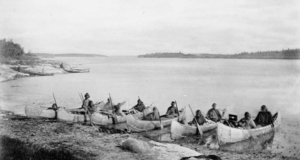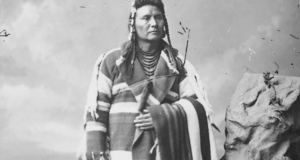Featured Article:Controversial Kin: Transracial Adoption in "Hope Leslie" and "Ramona"
By
2013, Vol. 5 No. 10 | pg. 4/4 | « When Senora Ortegna dies four years after she has adopted Ramona, it only continues the cycle of Ramona’s displacement. And with this shift in families, Ramona also shifts from lambasting the U.S. government and its policies to attacking the prejudices and morally erroneous desires of the American public. Whereas Senora Ortegna finds the adoption somewhat objectionable because Ramona is removed from her mother for strange and problematic reasons, Senora Moreno dislikes the adoption because of the child’s race. “She did not wish any dealings with such alien and mongrel blood,” Ramona elaborates. Senora Moreno then states, “‘If the child were pure Indian, I would like it better” (Jackson, 1884, p. 52). Analogously, Jackson saw that Americans were often reluctant to defend the well being of the Native Americans on account of their racial heritage and their supposed savagery. To the young Ramona, Senora Moreno is only a manipulator and a prejudiced—not to mention sexist—taskmaster. In A Century of Dishonor, Jackson (1881) explains that the U.S. government had been allowed to oppress the Native Americans for so long because the “wide-spread sentiment among the people of dislike to the Indian” (p. 338). Essentially, public sentiment not only bolstered the government’s ability to oppress the Native Americans, but the people’s opinion was also what influenced the government to carry out these policies in the first place. In the same way, Senora Moreno is described by her subtle but powerful influence on the workings of the household. The introduction to the text makes clear that, “In truth, it was not Felipe, but the Senora, who really decided all questions from greatest to least, and managed everything on the place. … A tremendous force, wherever she appeared, was Senora Moreno” (Ramona, 1884, p. 4). If Felipe were the head, then Senora Moreno was the neck that could turn the head wherever it wanted, as was the public’s relationship to its government. Furthermore, Ramona further indicts the nation for letting greed and economic interests drive public sentiment rather than empathy. Carlson and Roberts (2006) argue that “the Removal Act and the Preemption Act represent two sides of the same coin: the desire of settlers to acquire land cheaply and the desire to open more Indian land for settlement” (p. 488). Essentially, American settlers were driven by a desire for riches and land in the West and only viewed Native Americans as objects in the way of that desire. In this same way, Ramona portrays Senora Moreno as a character that views Ramona and the jewels she comes with on an equal playing field. In other words, they are both objects in her eyes. Tellingly, only “after [the] jewels were in her possession,” did the Senora agree to care for and adopt the mixed-blooded girl (Jackson, 1884, p. 52). Ironically, the jewels become much more significant to the matriarch than to Ramona, whom they were meant to be gifted to as wedding dowry. The Senora worries obsessively over the fate of these jewels, and she dies, it is suggested, partially because the problem over the jewels goes unresolved for so many years. In contrast, Ramona seems to care little about these riches. After the Senora tries to coax Ramona out of getting married with the jewels as a bribe, the girl retorts, “The jewels, Senora, you can give to the Church… I shall marry Alessandro” (Jackson, 1884, p. 228). Here, Ramona is shown to put the Christian value of love above her desire for riches, making Senora Moreno, and the Christian-American public she represents, hypocrites in comparison.Clearly, the text means to depict Ramona’s adoptions into domestic spheres as less than ideal for the child. In the meantime, it also uses the patriarch and matriarch of two different households to represent two different arms of Indian removal and Indian oppression: the U.S. government and the American public. But like Hope Leslie, some adoptions in Ramona are less obvious than others. In a marked contrast from Hope Leslie, however, it is the same-race adoptions that become ambiguous, whereas transracial adoptions are discussed openly and early on in the novel and are clearly termed “adoptions.” In probably what is the first act that allows Ramona to exercise personal agency, she willingly escapes with Alessandro to live with him in an Indian tribe and to be acculturated into their ways of life. The situation certainly resembles the captivity narratives of the eighteenth and nineteenth century, where in white captives were abducted and then adopted into tribes. The key difference, of course, is that Ramona asks to be taken away, desires to be married to a Native American man, and seeks to be adopted into the Native American community. In contrast to the adoptions in the early part of the novel, Ramona is incorporated much more smoothly into the Native American way of life. Most significantly, her past is permitted to remain part of her identity, and at the same time, Ramona is allowed to take on a new identity as a “citizen” of the tribe. Before Ramona and Alessandro escape the Moreno household, Alessandro first does something that marks the impending adoptions as distinct from the ones of Ramona’s childhood: he changes her name. Ramona wonders why Alessandro does not call her Ramona, and he replies, “If I think of you by any other name than as my Senorita, it is usually by a name you never heard… In the Luiseno tongue that is Majel; that was what I thought my people would have called you, if you had come to dwell among us” (Jackson, 1884, p. 244). And later on, Alessandro introduces her to the Indian village by telling “of Ramona’s birth, of their marriage, and of her new name of adoption” (Jackson, 1884, p. 329). Ultimately, Ramona tells us that Native American notions of kinship allowed for a greater transformability of identity, while American and European familial bonds reaffirmed racial borders. And here is where Ramona suggests that America could learn from Native American kinship bonds. If the nation could dissolve racial borders instead of bolster them by only thinking of blood ties and race, it would be much more feasible for Native Americans to be considered U.S citizens and to gain a greater sense of national belonging. Alessandro, however, is not the only one to help incorporate Ramona into the fabric of Native American society. In the first break from strict realism in the text, Ramona breaks the language barrier with a Native American woman named Carmena through a semi-mystical process. “’She told you!’ repeated Alessandro. ‘How did you understand her speech?’ ‘I do not know. Was it not a strange thing?’ replied Ramona. ‘She spoke in your tongue, but I thought I understood her’” (Jackson, 1884, p. 301). And then in another otherworldly experience, Carmena begins to chant “‘Yes,’ said Carmena, gravely, ‘she is one of us!’… ‘One of us Alessandro! one of us!’” (p. 302). By breaking from reality, Ramona recognizes how difficult it might be to integrate Native Americans as legal and social U.S. citizens specifically because of the language barrier. If Ramona, as a Native American herself can only become a part of the Native American tribes with the help of the supernatural, how much more might it take for Native Americans to become “American” without the help of the supernatural? Although realistically impossible, the scene with Carmena does demonstrate the metamorphic effect that Native American adoption practices had on its adoptees. In contrast to the Moreno household’s adoption of Ramona, where she was made to feel alienated and like an “Other”—hence no name change—Carmena immediately makes Ramona feel accepted. This acceptance is so unconditional, Ramona suggests, that it even had a kind of spiritual power. Carmena chants “’she is one of us” without having any knowledge of Ramona’s race, class, social status, previous history, etc., and thus Ramona is integrated into the Native American community—no questions asked. Ramona is also not asked to give up her previous culture in order to assimilate into her new culture, unlike U.S. society, which demanded Native Americans give up their savage ways and begin to internalize Christian beliefs and American ways of life if they were to become citizens. In return for this universal acceptance, Ramona gives up her racial prejudices toward her adoptive community. “She no longer had repugnance to the thought of an Indian village,” Jackson writes of her heroine (p. 388). “She already felt a sense of kinship and shelter with any Indian people. She had become, as Carmena had said, ‘one of them’” (Jackson, 1884, p. 388). Essentially, Jackson suggests that a better method for Native American integration would be for the U.S. government and public could “adopt” Native Americans into the nation in the same fashion as Native Americans adopted Ramona into their community. Native American kinship practices were transformative and unconditional, and happened regardless of the race of the adoptee or the adoptee’s willingness to give up their past culture or race’s customs. It is because Jackson makes sure to extol the virtue of Native American adoption practices in Ramona that critics find it hard to categorize her completely as an assimilationist. Assimilation meant the Indian minority would be completely subsumed and made to internalize white America’s culture, religion, and values. But Ramona clearly does not promote this; instead Jackson wanted the Native Americans weaved into the fabric of the nation, without having to give up their ways of life, just like Aunt Ri’s hit-or-miss rug allowed the differently “mixed tints” (i.e. different races) to reveal themselves fully, which made for a “harmonious blending” and ultimately a more harmonious picture all together (Jackson, 1884, p. 395). Jackson rails against past Indian removal policies because it had rent an immense gash in her hope for a more fully racially integrated nation. As John Gonzales (2004) puts it, “For Indian-policy reformers, Indians represented the nation’s incompleteness by virtue of their distinct political and cultural existence even in defeat” and would serve as a “reminder of the ultimate failure of national completion… Both tribal sovereignty and the white belief in absolute Indian inhumanity” would have to be abolished “to complete the nation’s modernity” (p. 439). Only after this ideological change had been made could Indian-policy reformers attempt to tie the American nation and the Indian nations together as one united state. However, if the American government and public could take up some of the Native American’s adoption practices, Jackson proposes that it this might be possible. Just like adopting a child transformed them into kin, America could transform Native Americans into citizens, but this integration would not be successful if the Native Americans had to wipe out their whole cultural history to do so. In the end, Sedgwick’s Hope Leslie and Jackson’s Ramona illustrate how key female American authors were thinking about and arguing for Native American personhood through transracial adoption in the nineteenth century. Sedgwick envisioned an American that would allow for greater gender and racial tolerance, and Jackson helped carry out this vision by crusading specifically for the rights of Native American tribes in America. Hope Leslie sets out a new paradigm for white and Native contact—that of cross-racial care instead of cross-racial violence. The text then juxtaposes white and Native American adoption practices; this way, readers can clearly see for themselves how much more effective Native American kinship practices were at transforming the adoptee into a member of their society. And whereas Sedgwick leaves off her rhetoric at simply illustrating the differences between the two adoption practices, Jackson in Ramona actually argues that the U.S. should adopt this kind of inclusive and transformative practice itself in order to weave Native Americans into the fabric of the nation as humans and as citizens. Indian Removal policies had been a large step backward in these writers’ goals for a more egalitarian nation, but the transracial adoptions in Sedgwick’s Hope Leslie and Jackson’s Ramona showed that there was certainly a possibility for moving toward a racially integrated nation. ReferencesCarlson, L.A., & Roberts, M. A. (2006) Indian Lands, ‘Squatterism,’ and Slavery: Economic Interests and the Passage of the Indian Removal Act of 1830. Explorations In Economic History, 43(3), 486-504. Carp, W. E. (2002) Adoption in America: Historical Perspectives. Ann Arbor: University of Michigan. Gonzales, J. M. (2004). The Warp Of Whiteness: Domesticity And Empire In Helen Hunt Jackson's Ramona." American Literary History 16(3): 437-465. Jackson, H. H. (1965). A Century of Dishonor: A Sketch of the United States Government’s Dealings With Some of the Indian Tribes. Ed. Andrew Rolle. New York: Harper and Row. Jackson, H. H. (1884). Ramona, A Story. Charleston: Forgotten Books. 2012. Jerng, M. C. (2010). Claiming Others: Transracial Adoption and National Belonging. Minneapolis: University of Minnesota. Kawashima, Y. (1981). Adoption in Early America. Journal Of Family Law 20(4), 677- 696. Peters, R. (1831). The Case of The Cherokee Nation against The State of Georgia; Argued and Determined at The Supreme Court of the United States, January Term 1831. Philadephia: James Kay, Jun & Co. Phillips, K. (2003). Helen Hunt Jackson: A Literary Life. Berkeley: University of California. “Procure.” (N.d.) Def. 1. In Merriam-Webster’s Dictionary. Retrieved March 16, 2013, from http://www.merriam-webster.com/dictionary/procure?show=0 &t=1378059145 Rifkin, M. (2011). When Did Indians Become Straight: Kinship, the History of Sexuality, and Native Sovereignty. New York: Oxford University Press. Sedgwick, C. M. (1827). Hope Leslie; Or, Early Times in Massachusetts. Mineola: Dover. 2011. Strand, A. D. (2009). Language, Gender, and Citizenship in American Literature, 1789- 1919. New York: Routledge. 1.) Although stereotypical, Jackson imagines the Indian’s relationship with land as that of a daughter to the mother. An elder of the first tribe Alessandro and Ramona settle in pronounces, “‘It is well; I am your mother. The winds of the valley shall love you, and the grass shall dance when you come. The daughter looks on her mother’s face each day” (Ramona, 1884, p. 330). Suggested Reading from Inquiries Journal
Inquiries Journal provides undergraduate and graduate students around the world a platform for the wide dissemination of academic work over a range of core disciplines. Representing the work of students from hundreds of institutions around the globe, Inquiries Journal's large database of academic articles is completely free. Learn more | Blog | Submit Latest in Literature |
















